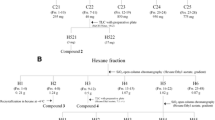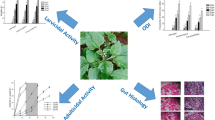Abstract
The deadliest insect, Culex pipiens, plays a critical role in the transmission of multiple diseases to livestock, animals, and humans. In the current work, the waste of Mangifera indica (Mango) seed kernels was extracted with ethyl acetate to profile the gallotannins components. Moreover, the major compounds pentagalloyl glucose (PGG) and mangiferin were isolated and their larvicidal activity against C. pipiens was determined. A total of 20 secondary metabolites were annotated based on high-performance liquid chromatography with photodiode array (PDA) detector and mass spectrometry (MS) detection. PGG and mangiferin were isolated and identified depending on different chromatographic and spectroscopic techniques. The extract exhibited good larvicidal activity against the 3rd larval instar of C. pipiens with LC50 value of 64.02 µg/ml, whereas those of pentagalloyl glucose and mangiferin were 169.38 and 232.15 µg/ml, respectively. The tested extract and the two isolated secondary metabolites exploited significant alterations for the tested enzymes (acetylcholinesterase, carboxylesterase, α-esterases, glutathione S-transferase, and cytochrome P-450 monooxygenase) compared to the untreated larvae with p < 0.01. The GST, carboxylesterase, and α-esterase have the main role in the detoxification of PGG and mangiferin. In conclusion, Mango waste could provide a cheap, available, and important source for tackling an environmental problem as an ecofriendly alternative to the currently used chemical insecticides.
Graphic Abstract
The strategy of our study using M. indica kernel against C. pipiens larvae.





Similar content being viewed by others
References
Cornet, S., Nicot, A., Rivero, A., Gandon, S.: Avian malaria alters the dynamics of blood feeding in Culex pipiens mosquitoes. Malar. J. 18(1), 1–6 (2019)
El-Naggar, H.A., Hasaballah, A.I.: Acute larvicidal toxicity and repellency effect of octopus cyanea crude extracts against the filariasis vector, Culex pipiens. J. Egypt. Soc. Parasitol. 48(3), 721–728 (2018)
Kumar, S., Thomas, A., Pillai, M.: Deltamethrin: promising mosquito control agent against adult stage of Aedes aegypti L. Asian Pac. J. Trop. Med. 4(6), 430–435 (2011)
Hasaballah, A.I., El-Naggar, H.A.: Antimicrobial activities of some marine sponges, and its biological, repellent effects against Culex pipiens (Diptera: Culicidae). Annu. Res. Rev. Biol. 12, 1–14 (2017)
Kumar, D., Kumar, P., Singh, H., Agrawal, V.: Biocontrol of mosquito vectors through herbal-derived silver nanoparticles: prospects and challenges. Environ. Sci. Pollut. Res. 27, 25987–26024 (2020)
Orwa, C., Mutua, A., Kindt, R., Jamnadass, R., Anthony, S.: Agroforestree Database: A Tree Reference and Selection Guide Version 4.0, vol. 15. World Agroforestry Centre, Nairobi (2009)
Silva, A.P.M., Oliveira, A.V., Pontes, S.M., Pereira, A.L., Rosa, M.F., Azeredo, H.M.: Mango kernel starch films as affected by starch nanocrystals and cellulose nanocrystals. Carbohydr. Polym. 211, 209–216 (2019)
El-Gied, A.A.A., Joseph, M.R., Mahmoud, I.M., Abdelkareem, A.M., Al Hakami, A.M., Hamid, M.E.: Antimicrobial activities of seed extracts of mango (Mangifera indica L.). Adv. Microbiol. (2012). https://doi.org/10.4236/aim.2012.24074
Lauricella, M., Lo Galbo, V., Cernigliaro, C., Maggio, A., Palumbo Piccionello, A., Calvaruso, G., Carlisi, D., Emanuele, S., Giuliano, M., D’Anneo, A.: The anti-cancer effect of Mangifera indica L. peel extract is associated to γH2AX-mediated apoptosis in colon cancer cells. Antioxidants 8(10), 422 (2019)
Hannan, A., Asghar, S., Naeem, T., Ullah, M.I., Ahmed, I., Aneela, S., Hussain, S.: Antibacterial effect of mango (Mangifera indica Linn.) leaf extract against antibiotic sensitive and multi-drug resistant Salmonella typhi. Pak. J. Pharm. Sci. 26(4), 715–719 (2013)
Kumar, S., Maheshwari, K.K., Singh, V.: Effects of Mangifera indica fruit extract on cognitive deficits in mice. J. Environ. Biol. 30(4), 563 (2009)
Berardini, N., Knödler, M., Schieber, A., Carle, R.: Utilization of mango peels as a source of pectin and polyphenolics. Innov. Food Sci. Emerg. Technol. 6(4), 442–452 (2005)
Jedele, S., Hau, A.M., von Oppen, M.: An analysis of the world market for mangoes and its importance for developing countries. In: Conference on International Agricultural Research for Development (2003)
Ravindran, V., Rajaguru, A.: Nutrient contents of some unconventional poultry feed. Indian J. Anim. Sci. 55, 58–61 (1985)
Diarra, S., Usman, B., Igwebuike, J.: Replacement value of boiled mango kernel meal for maize in broiler finisher diets. J. Agric. Biol. Sci. 5(1), 47–52 (2010)
Gunstone, F.D.: Minor specialty oils. In: Fereiddon, S. (ed.) Nutraceutical and Specialty Lipids and Their Co-products, pp. 105–140. CRC Press, Boca Raton (2006)
Schieber, A., Stintzing, F., Carle, R.: By-products of plant food processing as a source of functional compounds—recent developments. Trends Food Sci. Technol. 12(11), 401–413 (2001)
Beyene, G., Araya, A.: Review of mango (Mangifera indica) seed-kernel waste as a diet for poultry. J. Biol. Agric. Healthc. 5(11), 156 (2015)
Sruamsiri, S., Silman, P.: Nutritive value and nutrient digestibility of ensiled mango by-products. Maejo Int. J. Sci. Technol. 3(3), 371–378 (2009)
Dhingra, S., Kapoor, A.C.: Nutritive value of mango seed kernel. J. Sci. Food Agric. 36(8), 752–756 (1985)
Moore, L.: Mango (Mangifera indica L.). Plant Guide: USDA, National Resource Conservation Services, National Plant Data Team (2004).
Emam, M., Abdel-Haleem, D.R., Salem, M.M., Abdel-Hafez, L.J.M., Latif, R.R.A., Farag, S.M., Sobeh, M., El Raey, M.A.: Phytochemical profiling of Lavandula coronopifolia Poir. aerial parts extract and its larvicidal, antibacterial, and antibiofilm activity against Pseudomonas aeruginosa. Molecules 26(6), 1710 (2021)
Fischer, F., Dörfel, H.: Die polyuronsäuren der braunalgen (Kohlenhydrate der Algen I). Hoppe-Seyler s Zeitschrift für physiologische Chemie 302(1–2), 186–203 (1955)
Marrez, D.A., El Raey, M.A., El-Hagrassi, A.M., Seif, M.M., Ragab, T.I., El Negoumy, S.I., Emam, M.: Phenolic profile and antimicrobial activity of green synthesized Acalypha wilkesiana seed’s silver nanoparticles against some food borne pathogens. Biosci. Res. 14(4), 817–830 (2017)
Jayme, G., Knolle, H.: Paper chromatography of sugar mixtures on glass fiber papers. Angew. Chem.-Int. Edn. 68(7), 243–246 (1956)
Wang, M., Carver, J.J., Phelan, V.V., Sanchez, L.M., Garg, N., Peng, Y., Nguyen, D.D., Watrous, J., Kapono, C.A., Luzzatto-Knaan, T.: Sharing and community curation of mass spectrometry data with Global Natural Products Social Molecular Networking. Nat. Biotechnol. 34(8), 828–837 (2016)
Gerberg, E.J., Barnard, D.R., Ward, R.A.: Manual for Mosquito Rearing and Experimental Techniques. American Mosquito Control Association Inc., Baltimore (1994)
WH Organization: Guidelines for Laboratory Field Testing of Mosquito Larvicides. WHO, Geneva (2005)
Amin, T.: Biochemical and physiological studies of some insect growth regulators on the cotton leafworm. Spodoptera littoralis (Boisd.). Doctoral dissertation, Ph. D. thesis, Faculty of science, Cairo University (1998)
Simpson, D., Bull, D., Lindquist, D.: A semimicrotechnique for the estimation of cholinesterase activity in boll weevils. Ann. Entomol. Soc. Am. 57(3), 367–371 (1964)
Asperen, K.V.: A study of housefly esterases by means of a sensitive colorimetric method. J. Insect Physiol. 8(4), 401–414 (1962)
Habig, W., Pabst, M., Jarkoby, W.: Glutathione. The first enzymatic step in mercapturic acid formation. J. Biol. Chem. 249, 7130–7139 (1974)
Hansen, L., Hodgson, E.: Biochemical characteristics of insect microsomes: N-and O-demethylation. Biochem. Pharmacol. 20(7), 1569–1578 (1971)
Duncan, D.B.: Multiple range and multiple F tests. Biometrics 11(1), 1–42 (1955)
Zhao, W.-H., Gao, C.-C., Ma, X.-F., Bai, X.-Y., Zhang, Y.-X.: The isolation of 1, 2, 3, 4, 6-penta-O-galloyl-beta-D-glucose from Acer truncatum Bunge by high-speed counter-current chromatography. J. Chromatogr. B 850(1–2), 523–527 (2007)
Beretta, G., Artali, R., Caneva, E., Maffei Facino, R.: Conformation of the tridimensional structure of 1,2,3,4,6-pentagalloyl-β-d-glucopyranose (PGG) by 1H NMR, NOESY and theoretical study and membrane interaction in a simulated phospholipid bilayer: a first insight. Magn. Reson. Chem. 49(3), 132–136 (2011)
Talamond, P., Mondolot, L., Gargadennec, A., de Kochko, A., Hamon, S., Fruchier, A., Campa, C.: First report on mangiferin (C-glucosyl-xanthone) isolated from leaves of a wild coffee plant, Coffea pseudozanguebariae (Rubiaceae). Acta Botan. Gall. 155(4), 513–519 (2008)
Cho, J.-Y., Sohn, M.-J., Lee, J., Kim, W.-G.: Isolation and identification of pentagalloylglucose with broad-spectrum antibacterial activity from Rhus trichocarpa Miquel. Food Chem. 123(2), 501–506 (2010)
Gómez-Caravaca, A.M., López-Cobo, A., Verardo, V., Segura-Carretero, A., Fernández-Gutiérrez, A.: HPLC-DAD-q-TOF-MS as a powerful platform for the determination of phenolic and other polar compounds in the edible part of mango and its by-products (peel, seed, and seed husk). Electrophoresis 37(7–8), 1072–1084 (2016)
Engels, C., Gänzle, M.G., Schieber, A.: Fast LC–MS analysis of gallotannins from mango (Mangifera indica L.) kernels and effects of methanolysis on their antibacterial activity and iron binding capacity. Food Res. Int. 45(1), 422–426 (2012)
Berardini, N., Carle, R., Schieber, A.: Characterization of gallotannins and benzophenone derivatives from mango (Mangifera indica L. cv. ‘Tommy Atkins’) peels, pulp and kernels by high-performance liquid chromatography/electrospray ionization mass spectrometry. Rapid Commun. Mass Spectrom. 18(19), 2208–2216 (2004)
Devanand, P., Rani, P.U.: Biological potency of certain plant extracts in management of two lepidopteran pests of Ricinus communis L. J. Biopest. 1(2), 170–176 (2008)
Rahuman, A.A., Bagavan, A., Kamaraj, C., Vadivelu, M., Zahir, A.A., Elango, G., Pandiyan, G.: Evaluation of indigenous plant extracts against larvae of Culex quinquefasciatus Say (Diptera: Culicidae). Parasitol. Res. 104(3), 637 (2009)
Alwala, O., Wanzala, W., Inyambukho, R., Osundwa, E., Ndiege, I.: Characterization and evaluation of repellent effect of essential oil of Mangifera indica L. from Kenya. J. Essent. Oil Bear. Plants 13(1), 85–96 (2010)
Jesikha, M.: Control of Musca domestica using wastes from Citrus sinensis peel and Mangifera indica seed. SIRJ-Bes 1(1), 17–26 (2014)
Kaitaniemi, P., Ruohomäki, K., Ossipov, V., Haukioja, E., Pihlaja, K.: Delayed induced changes in the biochemical composition of host plant leaves during an insect outbreak. Oecologia 116(1–2), 182–190 (1998)
Waliwitiya, R., Nicholson, R.A., Kennedy, C.J., Lowenberger, C.A.: The synergistic effects of insecticidal essential oils and piperonyl butoxide on biotransformational enzyme activities in Aedes aegypti (Diptera: Culicidae). J. Med. Entomol. 49(3), 614–623 (2012)
Sengottayan, S.-N.: Physiological and biochemical effect of neem and other Meliaceae plants secondary metabolites against Lepidopteran insects. Front. Physiol. 4, 359 (2013)
Yuan, Y., Li, L., Zhao, J., Chen, M.: Effect of tannic acid on nutrition and activities of detoxification enzymes and acetylcholinesterase of the fall webworm (Lepidoptera: Arctiidae). J. Insect Sci. 20(1), 8 (2020)
Helmy, N., Bakr, R.F., Nawwar, G.A., Helmy, O.M.: Biochemical effects of some agricultural waste extracts against Culex pipiens (Diptera: Culicidae). Egypt. Acad. J. Biol. Sci. C Physiol. Mol. Biol. 2(2), 75–81 (2010)
Shoba, V.: Biochemical status and histological changes of Catharanthus roseus ethanolic leaves extract against mosquito larvae Aedes aegypti, Anopheles stephensi and Culex quinquifasciatus (Diptera: Culicidae). Int. J. Zool. Appl. Biosci. 3, 352 (2018)
Dahi, H.F., El-Sayed, Y.A., El-Barkey, N.M., Aziz, A.-E., Mona, F.: Toxicological and biochemical studies of Methylamine Avermactin, a new type of bioinsecticide against the cotton leafworm, Spodoptera littoralis (Biosd). Egypt. Acad. J. Biol. Sci. A Entomol. 2(1), 103–116 (2009)
Bullangpoti, V., Wajnberg, E., Audant, P., Feyereisen, R.: Antifeedant activity of Jatropha gossypifolia and Melia azedarach senescent leaf extracts on Spodoptera frugiperda (Lepidoptera: Noctuidae) and their potential use as synergists. Pest. Manag. Sci. 68(9), 1255–1264 (2012)
Ebadollahi, A., Khosravi, R., Sendi, J.J., Honarmand, P., Amini, R.M.: Toxicity and physiological effects of essential oil from Agastache foeniculum (Pursh) Kuntze against Tribolium castaneum Herbst (Coleoptera: Tenebrionidae) larvae. Annu. Res. Rev. Biol. 3, 649–658 (2013)
Acknowledgements
The authors wish to thank Prof. M. Wink, Heidelberg University for giving us the opportunity to collect LC-MS data at his lab. This research did not receive any specific grant from funding agencies in the public, commercial, or not-for-profit sectors.
Author information
Authors and Affiliations
Contributions
Conception and design of study: ME, MAE, MS. Acquisition of data: DRA, MS, ME. Analysis and/or interpretation of data: DRA, SMF, MS, ME. Drafting the manuscript: DRA, SMF, MS, and ME. Revising the manuscript critically for important intellectual content: DRA, MS, ME and MAE. Approval of the version of the manuscript to be published: ME, DRA, SMF, MAE and MS.
Corresponding authors
Ethics declarations
Conflict of interest
There are no conflict of interest. None of the authors has any conflict of interest that could affect the performance of the work or the interpretation of the data.
Additional information
Publisher's Note
Springer Nature remains neutral with regard to jurisdictional claims in published maps and institutional affiliations.
Rights and permissions
About this article
Cite this article
Emam, M., Abdel-Haleem, D.R., Farag, S.M. et al. Larvicidal Activity of Pentagalloyl Glucose and Mangiferin Isolated from the Waste of Mango Kernel Against Culex pipiens L.. Waste Biomass Valor 13, 83–93 (2022). https://doi.org/10.1007/s12649-021-01532-9
Received:
Accepted:
Published:
Issue Date:
DOI: https://doi.org/10.1007/s12649-021-01532-9




